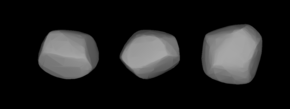378 Holmia
Appearance
 A three-dimensional model of 378 Holmia based on its light curve | |
| Discovery | |
|---|---|
| Discovered by | Auguste Charlois |
| Discovery date | 6 December 1893 |
| Designations | |
| (378) Holmia | |
| Pronunciation | ⫽ˈhoʊ(l)miə⫽ |
Named after | Stockholm |
| 1893 AP | |
| Main belt | |
| Orbital characteristics[1] | |
| Epoch 31 July 2016 (JD 2457600.5) | |
| Uncertainty parameter 0 | |
| Observation arc | 122.21 yr (44636 d) |
| Aphelion | 3.13602 AU (469.142 Gm) |
| Perihelion | 2.41546 AU (361.348 Gm) |
| 2.77574 AU (415.245 Gm) | |
| Eccentricity | 0.12980 |
| 4.62 yr (1689.1 d) | |
Average orbital speed | 17.88 km/s |
| 211.944° | |
| 0° 12m 47.254s / day | |
| Inclination | 7.00584° |
| 232.455° | |
| 157.769° | |
| Physical characteristics | |
| Dimensions | 26.74±1.7 km |
| 4.450 h (0.1854 d) | |
| 0.2971±0.043 | |
| 9.80 | |
Holmia (minor planet designation: 378 Holmia) is a typical Main belt asteroid.[2]
It was discovered by Auguste Charlois on 6 December 1893, in Nice.[3] The name comes from the Holmia, the Latin name for Stockholm, Sweden.[3]
References[edit]
- ^ "378 Holmia (1893 AP)". JPL Small-Body Database. NASA/Jet Propulsion Laboratory. Retrieved 10 May 2016.
- ^ Hirsch, R (2005). "Photometry and models of selected main belt asteroids". Astronomy and Astrophysics. 478 (2) (478 ed.): 329–335. Bibcode:2008A&A...478..559M. doi:10.1051/0004-6361:20078930.
- ^ a b Schmadel, Lutz D (11 November 2013). Dictionary of Minor Planet Names. Vol. 1 (3 ed.). Springer Science+Business Media. p. 70. ISBN 978-3-662-06615-7. OCLC 809148995.
External links[edit]
- 378 Holmia at AstDyS-2, Asteroids—Dynamic Site
- 378 Holmia at the JPL Small-Body Database
